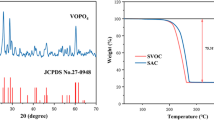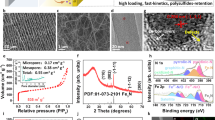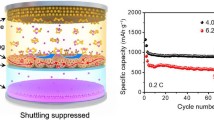Abstract
Lithium–sulfur batteries (LSBs) have attracted the attention of more and more researchers due to the advantages of high energy density, environmental friendliness, and low production cost. However, the low electronic conductivity of active material and shuttling effect of lithium polysulfides (LiPSs) limit the commercial development of LSBs. To solve these problems, we design a core–shell composite with nitrogen-doped carbon (NC) and two types of selenides (FeSe2-NC@ZnSe-NC). The FeSe2-NC@ZnSe-NC has a strong adsorption capacity, and can effectively adsorb LiPSs. At the same time, it also effectively alleviates the shuttling effect of LiPSs, and improves the utilization of the active substance during the charge/discharge reaction processes. The mechanism involved in FeSe2-NC@ZnSe-NC is demonstrated by both experiments and density-functional theory (DFT) calculations. The electrochemical test results indicate that LSB with S/FeSe2-NC@ZnSe-NC delivers an initial discharge capacity of 1260 mAh·g−1 at 0.2C. And after 500 cycles at 1C, the capacity decay rate per cycle is 0.031%, and the capacity retention rate is 85%. The FeSe2-NC@ZnSe-NC core–shell structure verifies a rational strategy to construct an electrode material for high-performance LSBs.
Graphical abstract

摘要
锂硫电池以其能量密度高、环境友好、生产成本低等优点受到越来越多研究者的关注。然而,活性物质的低电导率和多硫化锂的穿梭效应限制了多硫化锂的商业化发展。为了解决这些问题,我们设计了一种含有氮碳掺杂和两种硒化物的核壳复合材料(FeSe2-NC@ZnSe-NC)。FeSe2-NC@ZnSe-NC吸附能力强,能有效吸附多硫化锂。同时也有效缓解了多硫化锂的穿梭效应,提高了充放电反应过程中活性物质的利用率。通过实验和密度泛函理论计算,证明了FeSe2-NC@ZnSe-NC所涉及的机制。电化学测试结果表明,具有S/FeSe2-NC@ZnSe-NC的锂硫电池在0.2C下的初始放电容量为1260 mAh·g−1。在1C下循环500次后,每个循环的容量衰减率为0.031%,容量保持率为85%。FeSe2-NC@ZnSe-NC核壳结构验证了构建高性能锂硫电池电极材料的合理策略。







Similar content being viewed by others
References
Liu YT, Liu S, Li GR, Yan TY, Gao XP. High volumetric energy density sulfur cathode with heavy and catalytic metal oxide host for lithium–sulfur battery. Adv Sci. 2020;7(12):1903693. https://doi.org/10.1002/advs.201903693.
Grey CP, Hall DS. Prospects for lithium-ion batteries and beyond a 2030 vision. Nat Commun. 2020;11:6279. https://doi.org/10.1038/s41467-020-19991-4.
Vu A, Qian Y, Stein A. Porous electrode materials for lithium-ion batteries-how to prepare them and what makes them special. Adv Energy Mater. 2012;2:1056. https://doi.org/10.1002/aenm.201200320.
Jung JW, Cho SH, Nam JS, Kim ID. Current and future cathode materials for non-aqueous Li-air (O2) battery technology—a focused review. Energy Storage Mater. 2020;2020(24):512. https://doi.org/10.1016/j.ensm.2019.07.006.
Peng HJ, Huang JQ, Cheng XB, Zhang Q. Review on high-loading and high-energy lithium–sulfur batteries. Adv Energy Mater. 2017;7(24):1700260. https://doi.org/10.1002/aenm.201700260.
Deng RY, Wang M, Yu HY, Luo SR, Li JH, Chu FL, Liu B, Wu FX. Recent advances and applications toward emerging lithium–sulfur batteries: working principles and opportunities. Energy Environ Mater. 2022;5(3):777. https://doi.org/10.1002/eem2.12257.
Jin BY, Yang LF, Zhang JW, Cai YJ, Zhu J, Lu JG, Hou Y, He QG, Xing HB, Zhan XL, Chen FQ, Zhang QH. Bioinspired binders actively controlling ion migration and accommodating volume change in high sulfur loading lithium–sulfur batteries. Adv Energy Mater. 2019;9(48):1902938. https://doi.org/10.1002/aenm.201902938.
Chen L, Sun YJ, Wei XJ, Song LX, Tao G, Cao X, Wang D, Zhou GM, Song YZ. Dual-functional V2C MXene assembly in facilitating sulfur evolution kinetics and Li-ion sieving toward practical lithium–sulfur batteries. Adv Mater. 2023;35(26):2300771. https://doi.org/10.1002/adma.202300771.
Cao X, Wang ML, Li YL, Chen L, Song LX, Cai WL, Zhang W, Song YZ. Nitrogen balance on Ni-N-C promotor for high-energy lithium–sulfur pouch cells. Adv Sci. 2022;9(33):2204027. https://doi.org/10.1002/advs.202204027.
Zhang X, Liu XH, Zhang W, Song YZ. Tunable vacancy defect chemistry on free-standing carbon cathode for lithium–sulfur batteries. Green Energy Environ. 2023;8(2):354. https://doi.org/10.1016/j.gee.2022.03.006.
Song YZ, Gao H, Wang ML, Chen L, Cao X, Song LX, Liu XH, Cai WL, Sun JY, Zhang W. Deciphering the defect micro-environment of graphene for highly efficient Li-S redox reactions. EcoMat. 2022;4(3):e12182. https://doi.org/10.1002/eom2.12182.
Zhang BB, Lu RC, Cheng YL, Amin K, Mao LJ, Wei ZX. Sulfur compensation: a promising strategy against capacity decay in Li–S batteries. ACS Appl Mater Interfaces. 2021;13(49):58771. https://doi.org/10.1021/acsami.1c19598.
Hou LP, Li Z, Yao N, Bi CX, Li BQ, Chen X, Zhang XQ, Zhang Q. Weakening the solvating power of solvents to encapsulate lithium polysulfides enables long-cycling lithium–sulfur batteries. Adv Mater. 2022;34(45):2205284. https://doi.org/10.1002/adma.202205284.
Ye HL, Li YG. Towards practical lean-electrolyte Li–S batteries: highly solvating electrolytes or sparingly solvating electrolytes? Nano Res Energy. 2022;1:e9120012. https://doi.org/10.26599/NRE.2022.9120012.
Chen Y, Wang TY, Tian HJ, Su DW, Zhang Q, Wang GX. Advances in lithium–sulfur batteries: from academic research to commercial viability. Adv Mater. 2021;33(29):2003666. https://doi.org/10.1002/adma.202003666.
Xiao QH, Yang JL, Wang XF, Deng YR, Han P, Yuan N, Zhang L, Feng M, Wang CA, Liu RP. Carbon-based flexible self-supporting cathode for lithium–sulfur batteries: progress and perspective. Carbon Energy. 2021;3(2):271. https://doi.org/10.1002/cey2.96.
Feng S, Fu ZH, Chen X, Zhang Q. A review on theoretical models for lithium–sulfur battery cathodes. InfoMat. 2022;4(3): e12304. https://doi.org/10.1002/inf2.12304.
Wang WY, Hou MX, Han FQ, Yu D, Liu J, Zhang Q, Yu FL, Wang L, He MS. Three-in-one LaNiO3 functionalized separator boosting electrochemical stability and redox kinetics for high-performance Li–S battery. J Energy Chem. 2023;82:581. https://doi.org/10.1016/j.jechem.2023.03.046.
Wang YZ, Huang XX, Zhang SQ, Hou YL. Sulfur hosts against the shuttle effect. Small Methods. 2018;2(6):1700345. https://doi.org/10.1002/smtd.201700345.
Zhang M, Chen W, Xue LX, Jiao Y, Lei TY, Chu JW, Huang JW, Gong CH, Yan YC, Hu Y, Wang XF, Xiong J. Adsorption-catalysis design in the lithium–sulfur battery. Adv Energy Mater. 2020;10(2):1903008. https://doi.org/10.1002/aenm.201903008.
Deng WJ, Phung J, Li G, Wang XL. Realizing high-performance lithium–sulfur batteries via rational design and engineering strategies. Nano Energy. 2021;82:105761. https://doi.org/10.1016/j.nanoen.2021.105761.
Zhang Q, Zhang X, Lei D, Qiao SM, Wang Q, Shi XS, Huang CH, He GH, Zhang FX. MOF-derived hollow carbon supported nickel-cobalt alloy catalysts driving fast polysulfide conversion for lithium–sulfur batteries. ACS Appl Mater Interfaces. 2023;15(12):15377. https://doi.org/10.1021/acsami.2c21903.
Zeng P, Zhou X, Peng J, Huang XL, Chang BB, Chen CR, Chen MF, Zheng LP, Pei Y, Su JC, Wang XY. Promoting “strong adsorption” and “fast conversion” of polysulfides in Li–S batteries based on conductive sulfides host with hollow prism structure and surface defects. Adv Funct Mater. 2023;33(4):2211818. https://doi.org/10.1002/adfm.202211818.
Wang ML, Zhu YJ, Sun YJ, Zhao Y, Yang XZ, Wang XJ, Song YZ, Ci HN, Sun JY. A universal graphene-selenide heterostructured reservoir with elevated polysulfide evolution efficiency for pragmatic lithium–sulfur battery. Adv Funct Mater. 2023;33(6):2211978. https://doi.org/10.1002/adfm.202211978.
Wu J, Ye T, Wang YX, Yang PY, Wang QC, Kuang WY, Chen XL, Duan GH, Yu LM, Jin ZQ, Qin JQ, Lei YP. Understanding the catalytic kinetics of polysulfide redox reactions on transition metal compounds in Li–S batteries. ACS Nano. 2022;16(10):15734. https://doi.org/10.1021/acsnano.2c08581.
Yao Y, Chang CY, Sun H, Guo D, Li RR, Pu X, Zhai JY. Hollow Ni3Se4 with high tap density as a carbon-free sulfur immobilizer to realize high volumetric and gravimetric capacity for lithium–sulfur batteries. ACS Appl Mater Interfaces. 2022;14(22):25267. https://doi.org/10.1021/acsami.2c01951.
Yang DW, Zhang CQ, Biendicho JJ, Han X, Liang ZF, Du RF, Li MY, Li JS, Arbiol J, Llorca J, Zhou YT, Morante JR, Cabot A. ZnSe/N-doped carbon nanoreactor with multiple adsorption sites for stable lithium–sulfur batteries. ACS Nano. 2020;14(11):15492. https://doi.org/10.1021/acsnano.0c06112.
Dong C, Liu BK, Zhu DH, Chen D, Lu MJ, Cao JM, Wang YH, Huang WH, Shao Y, Tu HR, Han W. Ultrafine Co3Se4 nanoparticles in nitrogen-doped 3D carbon matrix for high-stable and long-cycle-life lithium sulfur batteries. Adv Energy Mater. 2020;10(19):1904273. https://doi.org/10.1002/aenm.201904273.
Zhang LN, Li TS, Zhang XC, Ma ZY, Zhou QP, Liu Y, Jiang XY, Zhang HY, Ni LB, Diao GW. Core-shell polyoxometalate-based zeolite imidazole framework-derived multi-interfacial MoSe2/CoSe2@NC enabling multi-functional polysulfide anchoring and conversion in lithium–sulfur batteries. J Mater Chem A. 2023;11:3105. https://doi.org/10.1039/D2TA08292F.
Hu SY, Wang TS, Lu BB, Wu D, Wang H, Liu XL, Zhang JH. Ionic-liquid-assisted synthesis of FeSe–MnSe heterointerfaces with abundant Se vacancies embedded in N, B Co-doped hollow carbon microspheres for accelerating the sulfur reduction reaction. Adv Mater. 2022;34(41):2204147. https://doi.org/10.1002/adma.202204147.
Sun WW, Li YJ, Liu SK, Liu C, Tan XJ, Xie K. Mechanism investigation of iron selenide as polysulfide mediator for long-life lithium–sulfur batteries. Chem Eng J. 2021;416: 129166. https://doi.org/10.1016/j.cej.2021.129166.
Delley B. An all-electron numerical method for solving the local density functional for polyatomic molecules. J Chem Phys. 1990;92:508. https://doi.org/10.1063/1.458452.
Blöchl P. Projector augmented-wave method. Phys Rev B. 1994;50(24):17953. https://doi.org/10.1103/PhysRevB.50.17953.
Delley B. Hardness conserving semilocal pseudopotentials. Phys Rev B. 2002;66(15):155125. https://doi.org/10.1103/PhysRevB.66.155125.
Rossmeisl J, Nørskov J, Taylor CD, Janik MJ, Neurock M. Calculated phase diagrams for the electrochemical oxidation and reduction of water over Pt(111). J Phys Chem B. 2006;110(43):21833. https://doi.org/10.1021/jp0631735.
Alberty RA. Standard Gibbs free energy, enthalpy, and entropy changes as a function of pH and pMg for several reactions involving adenosine phosphates. J Biol Chem. 1969;244(12):3290. https://doi.org/10.1016/0019-2791(69)90289-4.
Dassanayake AC, Wickramaratne NP, Hossain MA, Perera MA, Jeskey J, Huang SD, Shen H, Jaroniec M. Prussian blue-assisted one-pot synthesis of nitrogen-doped mesoporous graphitic carbon spheres for supercapacitors. J Mater Chem A. 2019;7:22092. https://doi.org/10.1039/C9TA08454A.
Qin ZG, Chen B, Mao Y, Shi C, Li Y, Huang X, Yang F, Gu N. Achieving ultrasmall prussian blue nanoparticles as high-performance biomedical agents with multifunctions. ACS Appl Mater Interfaces. 2020;12(51):57382. https://doi.org/10.1021/acsami.0c18357.
Zhou PC, Xiao F, Weng RX, Huang QG, Wang L, He QH, Tang WS, Yang PL, Su R, He P, Jia B, Bian L. PVP derived nitrogen-doped porous carbon integrated with polyindole: nano/microspheres assembled by emulsion polymerization for asymmetric supercapacitors. J Mater Chem A. 2022;10:10514. https://doi.org/10.1039/D2TA00102K.
Gao XW, Yang JH, Song KS, Luo WB, Dou SX, Kang YM. Robust FeCo nanoparticles embedded in a N-doped porous carbon framework for high oxygen conversion catalytic activity in alkaline and acidic media. J Mater Chem A. 2018;6:23445. https://doi.org/10.1039/C8TA06382F.
Godiya CB, Revadekar C, Kim J, Park BJ. Amine-bilayer-functionalized cellulose-chitosan composite hydrogel for the efficient uptake of hazardous metal cations and catalysis in polluted water. J Hazard Mater. 2022;15(436):129112. https://doi.org/10.1016/j.jhazmat.2022.129112.
Feng J, Luo SH, Zhan Y, Yan SX, Li PW, Zhang L, Wang Q, Zhang YH, Liu X. Ingeniously designed yolk-shell-structured FeSe2@NDC nanoboxes as an excellent long-life and high-rate anode for half/full Na-ion batteries. ACS Appl Mater Interfaces. 2021;13(43):51095. https://doi.org/10.1021/acsami.1c16957.
Wang B, Sun DY, Ren YL, Zhou XY, Ma YJ, Tang SC, Meng XK. MOFs derived ZnSe/N-doped carbon nanosheets as multifunctional interlayers for ultralong-life lithium–sulfur batteries. J Mater Sci Technol. 2022;125:97. https://doi.org/10.1016/j.jmst.2022.02.030.
Wu XX, Zhou C, Dong CX, Shen CL, Shuai BB, Li C, Li Y, An QY, Xu X, Mai LQ. Polydopamine-assisted in-situ formation of dense MOF layer on polyolefin separator for synergistic enhancement of lithium–sulfur battery. Nano Res. 2022;15:8048. https://doi.org/10.1007/s12274-022-4423-2.
Li H, Zhao M, Jin B, Wen Z, Liu HK, Jiang Q. Mesoporous nitrogen-doped carbon nanospheres as sulfur matrix and a novel chelate-modified separator for high-performance room-temperature Na–S batteries. Small. 2020;16(29):1907464. https://doi.org/10.1002/smll.201907464.
Hou YL, Zhang J, Qin T, Zeng R, Guan HB, Wang SG, Zhao DL. Spindle-like Fe7S8/C anchored on S-doped graphene nanosheets as a superior long-life and high-rate anode for lithium-ion batteries. Appl Surf Sci. 2022;599:154042. https://doi.org/10.1016/j.apsusc.2022.154042.
Li H, Zhou YT, Zhao M, Jin B, Wen Z, Xie HM, Dou SX, Jiang Q. Suppressed shuttle via inhibiting the formation of long-chain lithium polysulfides and functional separator for greatly improved lithium-organosulfur batteries performance. Adv Energy Mater. 2020;10(3):1902695. https://doi.org/10.1002/aenm.201902695.
Liu JB, Lin CJ, Xie QS, Peng DL, Xie RJ. Core-shell zeolite imidazole framework-derived ZnSe@CoSe2/C heterostructure enabling robust polysulfide adsorption and rapid Li+ diffusion in high-rate and high-loading lithium-sulfur batteries. Chem Eng J. 2022;430:133099. https://doi.org/10.1016/j.cej.2021.133099.
Ye ZQ, Jiang YJ, Yang TY, Li L, Wu F, Chen RJ. Engineering catalytic CoSe-ZnSe heterojunctions anchored on graphene aerogels for bidirectional sulfur conversion reactions. Adv Sci. 2022;9(1):2103456. https://doi.org/10.1002/advs.202103456.
Dong CW, Zhou HY, Jin B, Gao W, Lang XY, Li JC, Jiang Q. Enabling high-performance room-temperature sodium/sulfur batteries with few-layer 2H-MoSe2 embellished nitrogen-doped hollow carbon spheres as polysulfide barriers. J Mater Chem A. 2021;9:3451. https://doi.org/10.1039/D0TA10159A.
Wu L, Zhao YF, Yu Y, Liang B, Pang H, Xie HJ. FeS2 intercalated montmorillonite as a multifunctional separator coating for high-performance lithium–sulfur batteries. Inorg Chem Front. 2023;10:651. https://doi.org/10.1039/D2QI02324E.
Liu H, Yang XJ, Jin B, Cui MY, Li YY, Li QC, Li L, Sheng QD, Lang XY, Jin EM, Jeong SM, Jiang Q. Coordinated immobilization and rapid conversion of polysulfide enabled by a hollow metal oxide/sulfide/nitrogen-doped carbon heterostructure for long-cycle-life lithium–sulfur batteries. Small. 2023;19(32):2300950. https://doi.org/10.1002/smll.202300950.
Dong CW, Zhou HY, Liu H, Jin B, Wen Z, Lang XY, Li JC, Kim JW, Jiang Q. Inhibited shuttle effect by functional separator for room-temperature sodium–sulfur batteries. J Mater Sci Technol. 2022;113:207. https://doi.org/10.1016/j.jmst.2021.10.027.
Zhu Q, Xu HF, Shen K, Zhang YZ, Li B, Yang SB. Efficient polysulfides conversion on Mo2CTx MXene for high-performance lithium–sulfur batteries. Rare Met. 2022;41(1):311. https://doi.org/10.1007/s12598-021-01839-5.
Gu LL, Gao J, Wang C, Qiu SY, Wang KX, Gao XT, Sun KN, Zuo PJ, Zhu XD. Thin-carbon-layer-enveloped cobalt-iron oxide nanocages as a high-efficiency sulfur container for Li–S batteries. J Mater Chem A. 2020;8:20604. https://doi.org/10.1039/D0TA07579E.
Li M, Yang D, Biendicho JJ, Han X, Zhang C, Liu K, Diao J, Li J, Wang J, Heggen M, Dunin-Borkowski RE. Enhanced polysulfide conversion with highly conductive and electrocatalytic iodine-doped bismuth selenide nanosheets in lithium–sulfur batteries. Adv Funct Mater. 2022;32(26):2200529. https://doi.org/10.1002/adfm.202200529.
Zuo JH, Zhai PB, He QQ, Wang L, Chen Q, Gu XK, Yang ZL, Gong YJ. In-situ constructed three-dimensional MoS2–MoN heterostructure as the cathode of lithium–sulfur battery. Rare Met. 2022;41(5):1743. https://doi.org/10.1007/s12598-021-01910-1.
Wang H, He SA, Cui Z, Xu CT, Zhu JQ, Liu Q, He GJ, Luo W, Zou RJ. Enhanced kinetics and efficient activation of sulfur by ultrathin MXene coating S-CNTs porous sphere for highly stable and fast charging lithium–sulfur batteries. Chem Eng J. 2021;420: 129693. https://doi.org/10.1016/j.cej.2021.129693.
Tong ZM, Huang L, Liu HP, Lei W, Zhang HJ, Zhang SW, Jia QL. Defective graphitic carbon nitride modified separators with efficient polysulfide traps and catalytic sites for fast and reliable sulfur electrochemistry. Adv Funct Mater. 2021;31(11):2010455. https://doi.org/10.1002/adfm.202010455.
Acknowledgements
This work was financially supported by the National Natural Science Foundation of China (No. 52130101) and the Project of Science and Technology Development Plan of Jilin Province in China (Nos. 20210402058GH and 20220201114GX).
Author information
Authors and Affiliations
Corresponding authors
Ethics declarations
Conflict of interests
The authors declare that they have no conflict of interest.
Supplementary Information
Below is the link to the electronic supplementary material.
Rights and permissions
Springer Nature or its licensor (e.g. a society or other partner) holds exclusive rights to this article under a publishing agreement with the author(s) or other rightsholder(s); author self-archiving of the accepted manuscript version of this article is solely governed by the terms of such publishing agreement and applicable law.
About this article
Cite this article
Li, L., Yang, XJ., Li, YY. et al. Inhibiting shuttle effect of lithium polysulfides by double metal selenides for high-performance lithium–sulfur batteries. Rare Met. 43, 2546–2559 (2024). https://doi.org/10.1007/s12598-024-02616-w
Received:
Revised:
Accepted:
Published:
Issue Date:
DOI: https://doi.org/10.1007/s12598-024-02616-w




